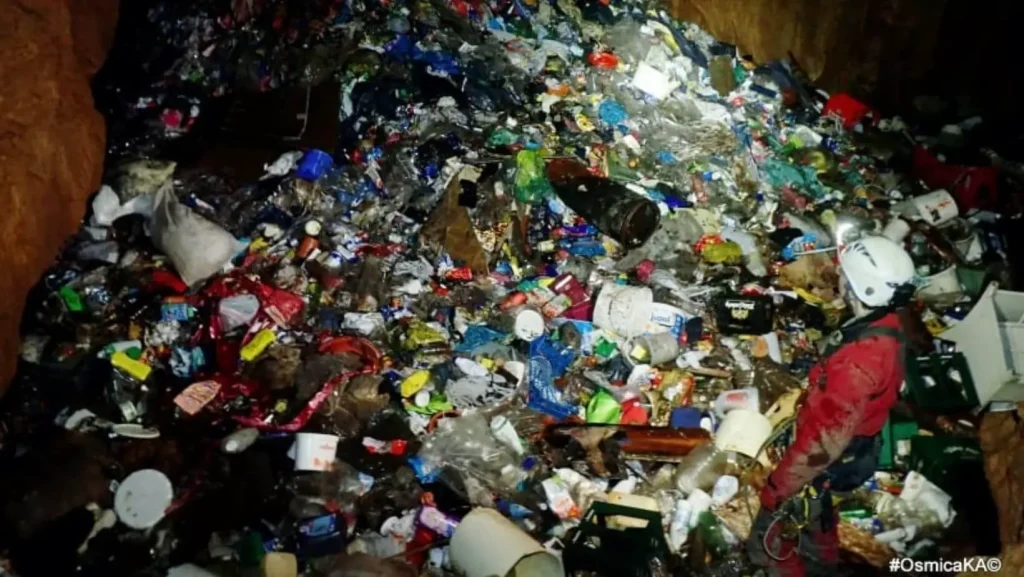The volunteer speleological initiative “Čisto podzemlje” (Clean Underground) is tirelessly fighting against throwing waste into the karst underground, and the increasing number of negligent scenes throughout Croatia has not discouraged them on their mission, reports Slobodna Dalmacija.
The association members shocked their Facebook followers after sharing photos of the huge landfill they found in Gaćina jama in the Biokovo hinterland, where waste from the densely populated area of Zagvozd ends up.
“Let’s wake up after the summer break. Cave reports about new underground atrocities are arriving … We start with the Gaća pit in the hinterland of Biokovo near Zagvozd. It is one of over 103 contaminated sites in the vicinity of Split (only a few have been cleaned).
The garbage in the pit is completely fresh … dumped from a nearby road yesterday. Local people injected over 100 cubic meters of household waste, carrion, bulky and construction waste, medicines, chemicals, and pesticides. So far, only we speleologists have seen the garbage, because the surroundings of the entrance are as clean as a tear, and in the underground a horror movie. Thank you, Osmica Karlovac, for reporting!”
“30 years of flattery and pain have come to fruition,” “We haven’t learned anything, nor will we,” “So what are uncivilized people doing to us?” “You will poison us all,” the comments below the post follow.
“We devastate everything we touch and, what’s craziest, we think we have a right to it,” another remarked.
“It is important that the biggest problem in Split is the new beach for dogs, because they will dirty the sea,” someone else protested.
The bottom of Gaćina jama has a diameter of 20 m, and as of this weekend, it is covered with more than a hundred cubic meters of waste. However, it remains unknown whether it extends further into the depths.
“There is carrion, large and small municipal waste, construction and hazardous waste, drugs, chemicals, pesticides,” it is stated on the association’s website.
Speleologist Ruđer Novak of the “Clean Underground” initiative says that over 900 similar locations have been detected in Croatia so far, but he notes that this is certainly not all.
The initiative has cleared dozens of underground landfills in recent years. But, unfortunately, it also happens that the cleaned site is very quickly refilled with waste.
“There were cases when we thought that we would clean the pit ‘once and for all, because the garbage in it is old, and the nearby village has been displaced. But then it happens that shortly after cleaning it, the weekenders come. In the abandoned villages, of course, there are no containers, so those who visit their grandparents to clean the old house, throw all the waste into the pit,” said Novak as one classic example.
“The whole village used the landfill in the hinterland of Biokovo for a long time. This is partly a matter of the population’s habit, which did not have organized waste collection until 15 or 20 years ago. It’s just that it was once dead sheep, wood and stones, and today plastic, car tires, TVs… So the composition of waste has changed, which is a great environmental threat,” said Novak.
The main problem, he points out, is the pollution of water, which seeps through the rubble and breaks through the waste deposits.
“Caves and pits are natural pathways by which surface water seeps into the underground, and it is the water that feeds our springs and makes up our water pumping station. In this case, the water is drained through landfills. This means that everything thrown into the pit eventually ends up in a glass on the table,” he warned.
He also notes that 70 percent of all Croatian endemic species are underground animals.
“The area of the Dinaric karst has the greatest diversity of underground fauna in the world; our country is unique in that respect,” he said.
Novak adds that people are sometimes unaware of the damage they are doing and stresses the importance of educating people in local communities, to whom no one has so far explained how wastewater ends up in their wells as well.
Speleologists have noticed that the majority of waste in Gaćina jama has been freshly dumped, which means that it is an active landfill.
“It is easy to unload a waste truck into a pit, while cleaning is very demanding,” said Novak.
He emphasizes that landfills contain not only plastic and electronic waste but also carrion and mines.
“We are closely cooperating with the Ministry of the Interior’s anti-explosion service since explosives were found in the pits not only from the Homeland War but also from the First and Second World Wars. Grenades found underground are full of heavy metals that decompose over decades and thus poison people and the environment,” he added.
Since cleaning underground landfills is a demanding and dangerous undertaking, only specially trained people can engage in it. Thus, interested and concerned citizens cannot participate in volunteer actions.
“There are 700 or 800 speleologists in Croatia. They are all volunteers. Only they and HGSS members are trained to clean landfills because they use speleological rescue techniques. Rope systems are used to bring the load to the surface. Civilians, unfortunately, cannot get involved in volunteering because it is physically impossible. So we are constrained in terms of the number of people,” the speleologist explained.
Novak notes that cleaning actions are possible thanks to donors, among which the leading retail chain is LIDL. Because of this, the association was allowed to change the model of functioning.
“We try to attract as many donors as possible so that we can continue this story. However, speleologists volunteers do work for which the state is not capable; no company on the market would deal with it,” Novak concluded.
For more on lifestyle in Croatia, follow TCN’s dedicated page.









